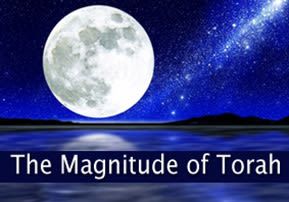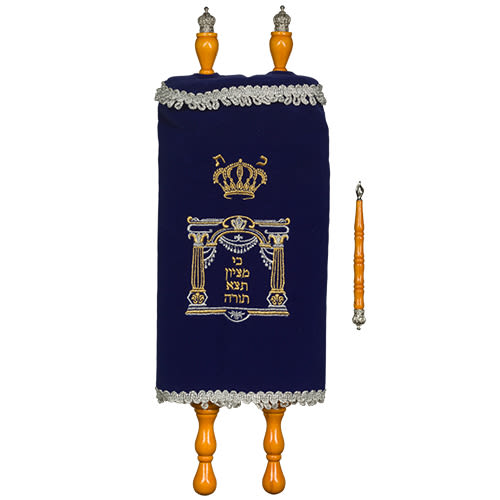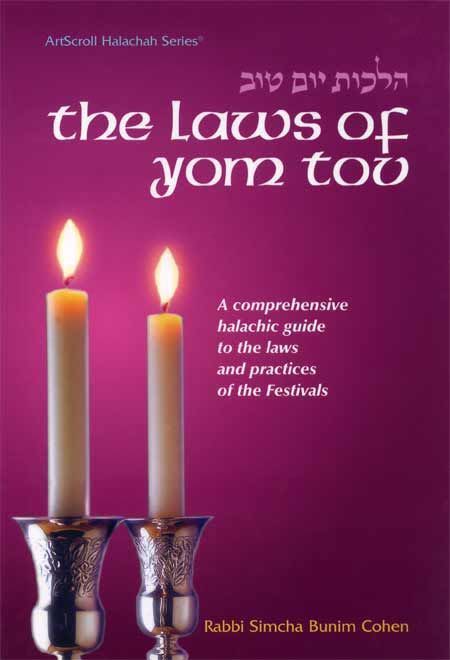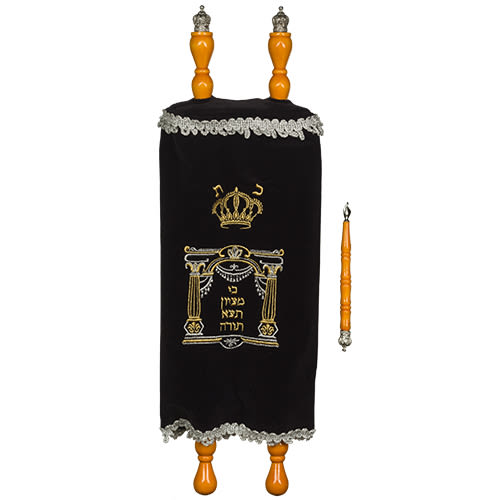
Simchat Torah: The Magnitude of Torah
For Simchat Torah - The Torah is only the tip of an iceberg! Infinite knowledge can be gleaned from the Written Law through inference by applying the 13 rules of Biblical exegesis. And then there is midrashim, gematria, kabbalah, and even modern-day Bible Codes!

It measures longer than the land and broader than the sea (Job 11:9).
So describes the verse the dimensions of a hypothetical scroll recording all of the Torah’s teachings. According to the Gemara (Eruvin 21a), the exact measurement of such a scroll is “3,200 times the size of the entire earth.”
Most of us are aware that the Written Law (the Pentateuch) is made up of five books which record, besides the early history of the Jewish People, 613 commandments. However, that is only the tip of the iceberg. A tremendous amount of knowledge can be gleaned from the Written Law through inference by applying to it the 13 rules of Biblical exegesis (or “Midot”). This wealth of information is collectively referred to as the Oral Law, since it is not spelled out explicitly in the Torah. In practice, however, it is deemed no less divine than the Written Law, since it may be deduced through the application of the 13 Midot, a rule system which Hashem gave over to Moshe on Mt. Sinai along with the Torah itself.
In fact, nearly all of the commentaries use the same general term to refer to both the explicit laws and the inferred laws: “Min Hatorah” (Biblical injunctions). The exception is the Rambam (Book of Mitzvot, Shoresh Hasheni; Hil. Ishus 1:2, 3:20; and many other places), who prefers to call the latter “Divrei Sofrim” (dictates of the Sages). Even the Rambam appears to admit that Divrei Sofrim are as legally binding as the explicitly written laws (Magid Mishneh, Hil. Ishus 1:2); it is not exactly clear why he found it necessary to grant them a title of their own. One plausible explanation is that the Rambam found one situation where we must indeed differentiate between the explicit and the non-explicit. A court of Jewish Law may override a previously accepted ruling only in matters of Divrei Sofrim, but not in matters that are considered to be explicit in the Torah (Rambam, Hil. Mamrim 2:1).
But the 13 Midot are not the end. In a Tanaitic text, Rebbi Eliezer, son of Rebbi Yosi Haglili, lists *32* Midos through which the Torah may be elucidated! The commentaries (Sefer Kerisus; Rav Yakov of Emden) explain the difference between the two lists of Midot. The 13 Midot are to be used to deduce Halachic rulings from the Written Law (or, “Drash”), while the 32 are used to explain the simple, non-Halachic, meanings of verses (or, “P’shat”), as is clear from Rebbi Eliezer’s own application of his rules. Perhaps for this reason, although applications of the 32 Midot are relatively rare in the Talmud, they are found quite often in Midrashic literature, which concentrates more on the meanings of verses than on the Halachot that are to be learned from them.
Rebbi Eliezer’s list of 32 includes some, but not all, of the previously mentioned 13 plus an entirely new batch of methodologies, such as the familiar Gematria and Notarikon (Midot #29,30). In Gematria, each of the Hebrew letters of a word are assigned a numerical (or sometimes alphabetical) value, based on certain rules. When the letters are then added up (or reread), they are shown to yield a value (which may be the value of another Hebrew word) which sheds insight into the meaning of the verse. Notarikon includes both acronyms, in which each letter of a word represents an entirely new word, and breaking down a long word into two smaller words which have meanings of their own.
When we extend our search for non-explicit teachings of the Torah to Kabbalistic Midrashim (such as Zohar and Tikunei Zohar) and other Kabbalistic works (such as those written by the Rishonim and the school of the Arizal), we find an entirely new set of methodologies. For example, one popular method to derive hidden meaning from the verse is by demonstrating that the beginning-letters or end-letters of a group of consecutive words spell an entirely new word, shedding light either on the verse in question or on the new word through the context of the verse. The reverse of an acronym, this method produces one word from many instead of many words from one.
Although the classical Midrashim do not make explicit reference to such methodologies, it seems clear that the Midrashim did indeed employ them to understand the deeper meaning of a verse. To take an example from the beginning of the Torah, the Midrash (Bereishit Raba 1:7) explains that the Torah begins with a reference to “Emet” (truth). It infers this from the fact that Hashem is referred to as “Elokim” in the first verse of the Torah, a designation which is associated with Emet other verses (such as Yirmeyahu 10:10). Although the Midrash does not mention that the end-letters of the three words which immediately follow the word “Bereishit” spell out “Emet” (as Matnot Kehunah ibid. points out), it is obvious that the Midrash had this in mind as well.
“Nifla’ot Mitoratecha,” a wonderful book recently printed by Rav Mordechai Aran (a neighbor of mine) in memory of his late father, makes use of the power of computers to seek out words that are represented in the Torah, Nevi’im and Kesuvim through strings of consecutive beginning-letters or end-letters. His well-documented and well-researched findings provide a striking list of some 250 words that fit amazingly well into the verses in which they are found. (The book can be ordered from the author directly at 17 Mishkelov St., Har Nof, Jerusalem, tel. 02-6518088, for $10+shipping.).
To offer just a few examples of some season-appropriate findings:
- SHOFAR: The word Shofar appears only once as a string of beginning-letters (and not even once as end-letters) in Melachim I:5:18, “There is no Satan, nor any harmful occurrence.” As the Talmud tells us (Rosh Hashanah 16b, and Tosfos), blowing the Shofar thwarts the Satan and prevents mishaps from affecting the Jewish People.
- TESHUVAH: The same applies to Teshuvah, whose sole appearance is among the words (Yirmeyahu 6:1), “Blow the Shofar….” The Rambam (Hil. Teshuvah 3:4) tells us, “The blowing of the Shofar hints to us that we must awaken ourselves from our slumber, investigate our deeds, and return to Hashem through Teshuvah.”
- LULAV: The word Lulav appears 4 times in beginning-letters, in verses in the Pentateuch. (It can be found once more as beginning-letters and once as end letters, but only by combining words from separate verses.) All four of the appearances are in words dealing with the Jews’ freedom from, and even dominion over, the other nations. (Bereishit 27:29; 45:8; Vayikra 26:5 are obvious. In Bereishit 40:9, “Lulav” appears as the butler begins to relate his dream to Yosef, an event which spurred Yosef’s freedom from the Egyptian prison and his meteoric rise to power.) Such appearances provide sensational support for the Midrash which attributes this exact significance to the Four Species:
The Jewish People and the other nations both come to lobby before Hashem on Rosh Hashanah. It is not clear who the winner is. But when the Jews leave the presence of Hashem with their Lulavim and Esrogim in their hands, we know that the Jewish People have won. (Vayikra Raba 30:3)
(The word Lulav, it should be noted, may refer specifically to the palm branch or, in a general sense, to the entire set of Four Species. An example of the latter is the blessing that is recited before taking the Species in hand.)
Recently, much turmoil has been caused by the discovery that Equidistant Number Sequences (ELS) — known to most people by their popular name, the Bible Codes — seem to produce meaningful patterns in the Pentateuch in a statistically significant manner. For all the novelty of the approach, it actually has its roots in ancient works. Although there does not seem to be any mention of ELS in Midrashic literature, Kabbalistic or otherwise, nevertheless it is mentioned in the works of the early commentators. The first recorded mention is in Rabbeinu Bachye, Bereishit end of 1:2. The Roke’ach (Rav Elazar of Mainz, c. 1210) includes ELS (or “Dilugin”) in a list of the *73* methods of elucidating the Torah (in “Sefer Hachochmah,” his introduction to Bereishit). How do these 73 methods fit in with the 13 and 32 methods mentioned above (section II)? And why are some of them not mentioned anywhere in Midrashic literature?
We are taught that there are four distinct approaches to the Torah: P’shat (simple meaning of the verses), Drush (Halachic derivations), Remez (veiled hints, which serve as the jumping point for Kabbalah) and Sod (which includes the body of Kabbalistic teachings) — see Maharsha to Eruvin 21a. Just as the 13 methods are exclusive to Drush and the 32 to P’shat, so too are the 73 exclusive to Remez, and another group exclusive to Kabbalah. This, it appears, is why the Midreshei Kabbalah only use the Kabbalah methodologies, while the Roke’ach, who specialized in Torat Haremez, used the 73 methodologies of Remez.
The recent revival of ELS findings was launched by the ingenious discoveries of Rav Michoel Ber Weismandel (d. 1958). With his brilliant mind and flawless memory, he managed to find ELS patterns in the Torah that nobody could possibly have dreamed of before him. For example, Megilat Ester (one of the Ketuvim) contains 12,110 letters, asserts Rav Weismandel. If you were to count exactly that number of letters from the first Aleph of the Torah (Ber*ei*shit), you will find a Samech, another 12,110 letters and you find a Tav, then a Reish. Altogether, that spells “Ester!” (This and numerous other ELS’s that Rav Weismandel discovered, such as the famous “Menorah,” are recorded in Torat Chemed, written by a student of his.)
The champions of the modern version of ELS are Doron Witzum (the discoverer) and Professor Eliyahu Rips of the Hebrew University in Jerusalem (the leading mathematician). Their model attempts to show that ELS’s of words that belong in the same group are indeed grouped together in the Torah in a statistically significant manner. The key words here are “statistically significant” – a typical word four letters in length can appear as an ELS some 300,000 times in the Torah. In order to show that his method produces statistically significant ELS’s, Dr. Witzum *first* chooses pairs of words that seem to be thematically related (such as “hammer” and “anvil,” or the name of a Torah authority and the date on which he passed away, or the name of the death-camp “Auschwitz” and the names of its daughter camps). Then, he looks for the following factors: (1) Does their ELS occur in relatively *close proximity* with each other? (2) Is he using relatively *short ELS’s* (that is, one of the lowest ELS’s in the Torah for any particular word), (3) Dr. Witzum takes into consideration the *infrequency* of the words with which he is dealing in order to produce a formula for what length ELS and what proximity is considered significant.
Although the mathematics gets complicated, the positive side is that the results can be presented in clear and impressive graphic format. (The mathematical equations themselves were presented for peer review and printed in a recent issue of Science.)
Certainly, we still haven’t discovered, and we probably will never discover, all of the methods for revealing the hidden teachings of the Torah. But at least we can get a taste from all of this of the full depth and breadth of the Torah.
***
Rabbi Mordechai Kornfeld of Har Nof, Jerusalem is an acclaimed Torah scholar who initiated the Daf Yomi Advancement Forum












Tell us what you think!
Thank you for your comment!
It will be published after approval by the Editor.